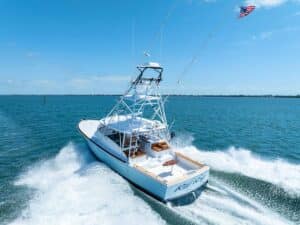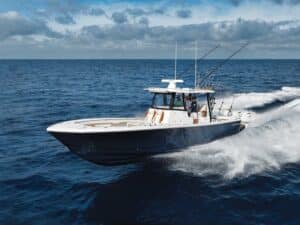
In total, just under 5,000 thefts of all types of watercraft were reported in 2016 and again in 2017, according to National Insurance Crime Bureau statistics. While many of these were, understandably, personal watercraft, many larger outboard boats were heisted as well.
Many stolen boats are simply stripped of everything valuable and the hull discarded in a secluded area or burned to make a trace difficult.
Outboard power is another target for those of the crooked persuasion, with thefts on the upswing, particularly in the Southeast. Boats in dry storage or on trailers make the easiest targets, and transoms holding multiple outboards promise a larger, more tempting payoff. Unlike boat hulls, outboards aren’t registered with some states’ motor-vehicle departments, making them difficult — if not impossible — to track.
While keeping your boat docked or parked (if on a trailer) at a safe, well-lit location is a major theft deterrent, you should still consider additional ways to protect it from thieves and burglars.
First Line of Defense
Keeping your trailered boat at home, if possible, is a best bet. However, those who opt or need to keep their boat in the water should be sure to install a kill switch in a hidden location. It won’t stop anyone from rummaging through your boat and removing valuable contents, parts and accessories, but it’s an effective way to prevent thieves from just cranking up your boat and driving away.
Security and Surveillance
Advances in marine electronics and wireless communications have vastly improved and augmented the security measures boat owners now have at their disposal to ward off criminals. Today, marine-security systems from companies such as Nautic-On and Siren Marine go far beyond incorporating an alarm and flashing lights to prompt intruders to flee. Some detect when the boat is moved and even track its location via GPS and cellular and/or satellite, giving you alerts and keeping you posted via mobile apps on your smart device or computer. Some sense when someone starts the boat’s engines or enters the salon or cabin.

Sensors and Detectors
A number of marine-security systems interface with a variety of sensors to monitor your boat. The GOST NT-Evolution 2.0 SM package from Global Ocean Security Technologies (gostglobal.com), with a price tag of about $5,000, interfaces with up to 64 wireless sensors. Along with a siren, high-intensity strobe, and pair of remote-key fobs for arming and disarming, it includes infrared motion sensors, a high-water sensor, a door or hatch sensor, and a pull sensor that detects if the boat pushes away from the dock. The system also detects if someone disconnects the boat batteries, if the battery voltage gets low, or if the boat starts to take on water. You can even link an optional smoke detector for added peace of mind.
Geo-Fencing
A software program known as geo-fencing, available in some systems’ location services, enables you to set up a safe zone or perimeter. If your boat leaves its perimeter, an alarm goes off, and you’re alerted immediately via your mobile device.
SPOT Trace ($100 plus a $100 annual service fee) is an economical GPS tracking option. Smaller than most cellphones, it’s easy to conceal in your boat, and has a lithium-ion-battery-powered GPS receiver and satellite communicator that can pinpoint your boat’s location within 25 feet, then notify you by text or email every five, 10, 30 and 60 minutes so you can track every move using Google Maps.
For an extra $199 a year, you can upgrade to Extreme Tracking service, which shortens the interval of the updates to just two and a half minutes.
Video Monitoring
Offsite streaming video is becoming an integral component of marine-security systems. Some systems let you use your cell or tablet as a monitor. GOST offers a great alternative, with its waterproof and impact-resistant Watch HD H2O surveillance system, part of the Evolution 2.0 SM package. With the free GOST Watch HD app, it connects to as many as six cameras to deliver video right to your wrist in real time.
The GOST Watch HD app also allows you to access and monitor the cameras from any iPhone or Android mobile device.
Trailer Safeguards
The vast majority of boats stolen (73 percent) are on trailers. If you plan to keep yours on a trailer, take a few precautions to avoid becoming another statistic.
For starters, don’t store your boat and trailer in a storage yard near a highway or heavily transited artery, where it’s likely to catch the eyes of crooks passing by. Keeping your rig in your yard, behind a locked fence and away from the street is considerably safer.
If possible, store your trailered boat backed up to a concrete building or solid block wall, giving bagmen little room to maneuver around the transom. (Thieves, on the other hand, can quickly cut through chain-link or wood fences on the property line.)
Trimax, Master Lock, Steal Shield, Reese, Fulton and other brands offer specialty locks ($10 to $40) for trailers. Designs and prices vary greatly, but most impede the hitch-to-coupler connection to keep thieves from simply hitching your trailer to their vehicle and driving away.
Opt for a heavy-duty trailer lock; it will be more rugged and difficult to cut or hacksaw off. And unless you store your trailer away from salt air and under covered parking, it’s smart to pay a little more for a lock made of rustproof and longer-lasting stainless steel.
Keep in mind that most trailers have a bolt-on coupler that serious thieves can easily remove and replace with one of their own, bypassing the lock. So if your boat and trailer remain unattended for long periods, also consider rendering the trailer immobile by binding the wheels or anchoring the trailer frame to a substantial immovable object — such as a tree or light pole — with a large-diameter (5⁄8- to 7⁄8-inch), industrial high-strength (grade 70 through 100) welded chain and a cut- and drill-resistant shrouded padlock, such as those made by Master Lock and Sobo.

Other Lockable Options
Marine electronics, trolling motors and fishing tackle are easy pickings for crooks targeting fishing boats. Locked compartments can deter pilferage during pit stops at marinas or lunch breaks at waterfront restaurants or overnight stays at a hotel while trailering long distances. When a boat is left unattended for lengthy periods, locked storage offers little resistance to a determined thief with a crowbar. It’s best not to leave any removable electronics, handheld VHF radios, binoculars, rods or other loose valuables on board between trips.
A number of specialty locks are available to protect those boat parts and accessories vulnerable to larceny. For example, DuraSafe makes locks that can be removed only with a special key to prevent removal of a trolling motor from the boat, and guard your VHF, chart plotter, fish finder and other marine-electronics units by securing them to their respective mounting brackets.
RAM Mounts offers additional alternatives, incorporating its trademarked Pin-Lock security knob and key to replace original knobs on your electronics units with some of its universal gimbal brackets.
Since outboards are plucked from trailered boats, secure yours with special transom bolts or clamping screw locks. For under $30, McGard offers corrosion-resistant locks that replace one of the mounting nuts on both outboards and outdrives. You need a special keyed tool to remove it, or the lock nut just spins. McGard incorporates the same design in a propeller lock and trailer-wheel locks that replace lug nuts on trailer wheels. SecureProp and BSafe secure your boat prop by covering the nut to prevent tampering.
Believe it or not, the fuel in a boat’s tank isn’t necessarily safe these days. Crooks are known to siphon it into portable tanks and haul it away. To keep thieves from leaving your tank dry, VETUS offers a simple device called Fuel Safe, which sells for less than $40 and prevents a siphon hose from being inserted in the deck filler and down into the tank. A locking fuel cap such as those made by Perko, SeaDog, Foresti & Suardi, Tank Lock and others is perhaps an easier answer. Opt for stainless steel over chrome-plated zinc or plastic.
Anti-Theft Microdots
Virtually invisible DNA microdots, the latest anti-theft weapon, can be painted on boat hulls, outboard motors, outdrives, marine electronics, fishing tackle and more. The size of a grain of sand, each is etched with a unique identification code that you register in the Law Enforcement National Recovery Database to increase the recovery odds of lost or stolen property.
Antitheftdots.com is the only company currently marketing this technology. Its Anti-Theft Dots Home/Business MicroKit ($32.95) provides users the simple tools to mark and register up to 50 different items, and a DNA Stealth Spray ($325) that can mark more than 500 items.
The DNA MicroKits include several warning decals to place on the windshield, console or other conspicuous locations around the boat to serve as a deterrent to criminals.
Lights Out
Trailer-boat owners can take a couple of other measures to prevent theft. Whenever boat and trailer will be out of action for a while, remove one of the trailer wheels to make the rig more difficult to haul away.
You can also build a removable contraption that holds the trailer lights and the trailer’s license plate, and is temporarily attached to the back of the boat or trailer with bungee cord, zip ties or Velcro straps only during actual trailering.
A high percentage of stolen boats disappear under the cover of darkness, when towing a boat without lights or proper tag might well attract the attention of law enforcement, so many thieves wouldn’t take the risk.
Cover All Bases
A boat cover does more than provide protection from the elements; it also serves as a theft deterrent. A tight-fitting canvas cover hides the boat’s interior and any flashy graphics that could get the boat noticed by prying eyes from the wrong element. Most thieves, who look for easy pickings, wouldn’t want to bother with unfastening a cover, a process that’s time-consuming and likely to attract attention.
A marine-canvas shop near you can custom-make a cover to fit your boat with the hardtop, tower, poling platform or whatever accessories you’ve had installed. But a number of brands offer more-affordable off-the-shelf choices, constructed with marine-grade synthetic fabrics that are water-repellent, mildew- and UV-resistant, and colorfast.
Don’t Announce That Vacation
Avoid posting on social media that you’re on vacation with the family (or for any reason away from home). That can tip off opportunistic boat thieves to an easy target.
A Boat’s Best Friend
Those who keep expensive boats at home benefit from security devices such as motion lights and security cameras. However, one of the most effective deterrents of all is man’s best friend. That doesn’t necessarily mean a Doberman or Rottweiler; any alert dog with a loud bark can do the job. (And letting would-be thieves know of your canine in advance with a prominent “Beware of Dog” sign doesn’t hurt a bit.)







